Harvard University made a fish out of human heart cells that can swim for 108 days
- Aspirin: Study Finds Greater Benefits for These Colorectal Cancer Patients
- Cancer Can Occur Without Genetic Mutations?
- Statins Lower Blood Lipids: How Long is a Course?
- Warning: Smartwatch Blood Sugar Measurement Deemed Dangerous
- Mifepristone: A Safe and Effective Abortion Option Amidst Controversy
- Asbestos Detected in Buildings Damaged in Ukraine: Analyzed by Japanese Company
Harvard University made a fish out of human heart cells that can swim for 108 days
- Red Yeast Rice Scare Grips Japan: Over 114 Hospitalized and 5 Deaths
- Long COVID Brain Fog: Blood-Brain Barrier Damage and Persistent Inflammation
- FDA has mandated a top-level black box warning for all marketed CAR-T therapies
- Can people with high blood pressure eat peanuts?
- What is the difference between dopamine and dobutamine?
- How long can the patient live after heart stent surgery?
Science: Harvard University made a fish out of human heart cells that can swim for 108 days.
The heart is like a tireless perpetual motion machine, life is constantly beating. But the regular beating of the heart is not dictated by the brain, but the cardiac muscle cells in the heart control the beating of the entire heart. However, the mechanisms that control this process are not fully understood.
On February 11, 2022, a research team from Harvard University and Emory University has grown a fully autonomous biological hybrid fish for the first time using human stem cell-derived cardiomyocytes , inspired by the morphology and movement posture of zebrafish .
The study was published in the top international academic journal Science under the title : An autonomously swimming biohybrid fish designed with human cardiac biophysics .
Using this autonomous swimming biological hybrid fish focusing on the key regulatory features of the human heart, the researchers revealed the myocardial pump The importance of feedback mechanisms .
The research team also said the discovery could in the future aid in the development of an artificial heart made of living cardiomyocytes to treat patients with severe defects in cardiac muscle function .

Video of a biohybrid fish swimming autonomously
Design and construction of biological hybrid fish
In the circulatory system, electrical signals and cardiac automaticity play a crucial role in regulating the speed and strength of myocardial contractions.
Autonomy of the heart originates from the sinoatrial node, which is structurally and functionally isolated from the surrounding myocardium and initiates spontaneous electrical activity in the absence of external stimulation and direct neural intervention.
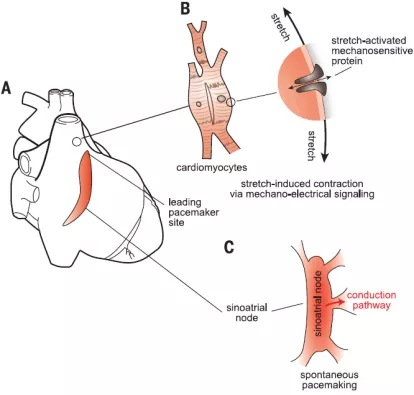
The researchers then used the principles of the heart control system to design a biological hybrid fish that could make the efficiency of the fluid-pumping system comparable to that of a natural fish fluid-pumping system. Using fundamental features of cardiac function, autonomous self-pacing and independent motor control can be achieved.
This biohybrid fish possesses antagonistic muscle bilayers and geometrically insulated cardiac tissue nodes containing human stem cell-derived cardiomyocytes (CMs). In the muscle bilayer structure of the biohybrid fish, the two sides of the CMs are mechanically coupled together, so that the contraction of one muscle can be directly translated into the axial stretching of the contralateral muscle, leading to the excitation and contraction of the antagonistic muscle .
To replicate the electrically insulating structure of the sinoatrial node, they created an electrical connection between the G node and muscle tissue through an outlet channel.
Therefore, the muscle bilayer and G-node of the biohybrid fish together allow it to generate a continuous rhythm to regulate muscle antagonism, resulting in spontaneous and coordinated body-caudal fin movements.
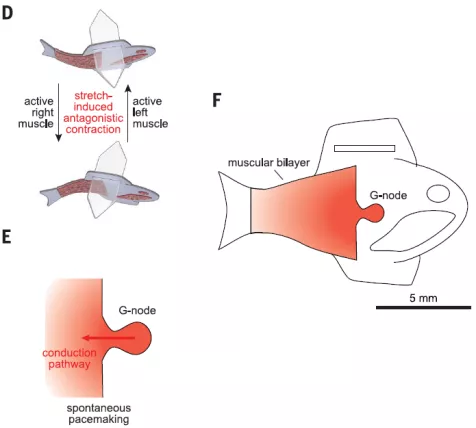
Optogenetically induced body stem-caudal fin propulsion pattern
To systematically characterize the kinematics of the muscle bilayer, they controlled antagonistic muscle contractions in biohybrid fish via external optogenetic stimuli. The muscle bilayer is stimulated alternately by blue and red light-emitting diode light pulses. Under red light stimulation, the left muscle tissue begins to contract; after blue light stimulation, the right muscle tissue is induced to contract, and the tail is retracted in a nearly straight posture. Biological hybrid fish A rhythmic forward continuous thrust is generated to achieve the advance .
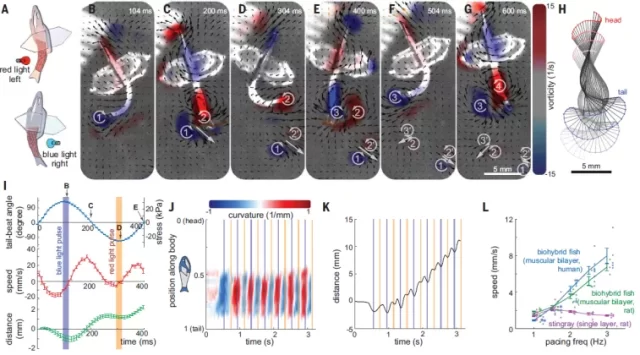
Spontaneous rhythmic contractions advancing movement
Next, they tested whether antagonistic muscle contractions reconstituted by human stem cell-derived cardiomyocytes could maintain spontaneous rhythmic contractions through mechanical electrical signaling.
It was found that spontaneous activation and contraction on one side of the biohybrid fish can lead to subsequent antagonistic contractions on the other side through mechanical coupling between muscle tissues.
These spontaneous antagonistic contractions cause the fish to undergo alternating bending movements that continue rhythmically. Shift forward . These phenomena demonstrate the spontaneous rhythmic contraction of the muscle bilayer.
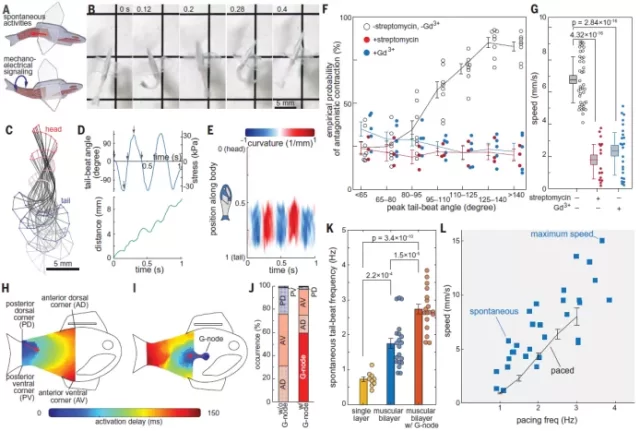
Long-term performance of biological hybrid fish
Considering the voluntary antagonistic muscle contractions of biohybrid fish, it is inevitable that some people will question whether this spontaneous activity can work in the long term.
In the end, the researchers kept the biohybrid fish spontaneously active for 108 days, the equivalent of 38 million heart beats .
It was found that the autonomous swimming biological hybrid fish continuously improved muscle contraction amplitude, maximum swimming speed and muscle coordination during the first month, and maintained good swimming performance for 108 days.
These data demonstrate the potential of the muscle bilayer system and electrical signaling as a means to promote the maturation of muscle tissue in vitro .
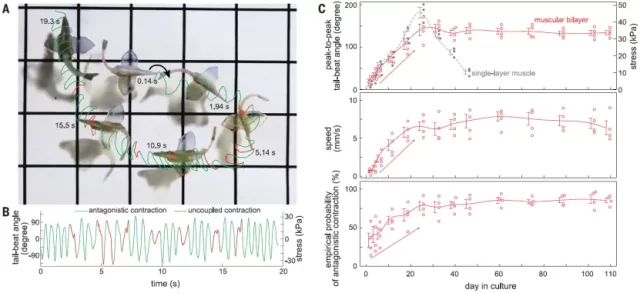
Research summary
In summary, the researchers drew design inspiration from the biophysics of the heart and used human stem cell-derived cardiomyocytes for the first time in the world to create this autonomous biological hybrid fish that can swim continuously for more than 100 days.
By building a “heart” by yourself to replicate the key biophysical principles in the heart’s work, it can help more detailed research on heart disease in the future .
Next, the team aims to create more complex biohybrid devices from human heart cells.
Professor Kevin Kit Parker , corresponding author of the study , said: “Our ultimate goal is to build an artificial heart to replace a deformed heart in a child. Much of the work in building cardiac tissue or hearts, including some of the work we have done, has focused on replicating the anatomy.
The ability to characterize or replicate the simple beating of the heart in engineered tissues will lead to more in-depth research towards the translational level in the future.”
Reference:
https://www.science.org/doi/10.1126/science.abh0474
Harvard University made a fish out of human heart cells that can swim for 108 days
(source:internet, reference only)
Disclaimer of medicaltrend.org
Important Note: The information provided is for informational purposes only and should not be considered as medical advice.



